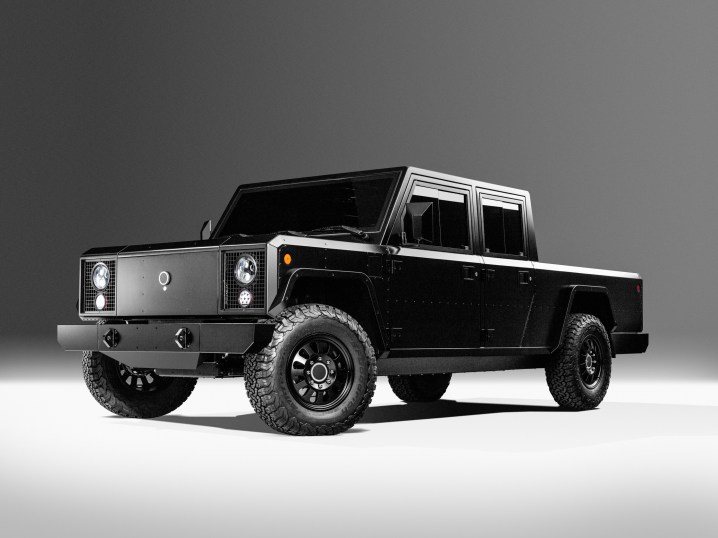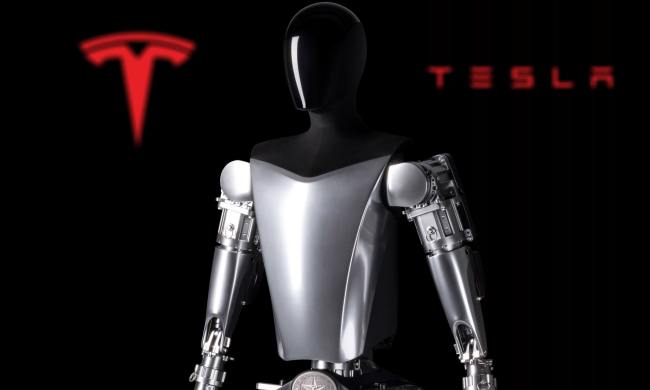
Imagine combining a Tesla Model S with a vintage Land Rover 4×4, and the result would look something like the Bollinger B1 and B2. The lines of these electric trucks are so straight and sharply creased, they’re eerily menacing. A Lamborghini Urus suddenly seems demure, and the new Land Rover Defender appears downright flowery in comparison. Of course, Bollinger’s preference for a Darth Vader-black exterior adds to the delightfully creepy aura, too.
Robert Bollinger, founder and CEO of the company that now bears his name, told us he first imagined his ‘perfect pickup’ after spending more than two decades in New York City, working at a successful career in marketing. He left the bustle of the Big Apple for a quieter life on a farm that he’d purchased in upstate New York. A used Chevy pickup truck got the job done, most times, but Bollinger figured a better truck was out there. The only problem, it didn’t yet exist.

Using his degree in industrial design while a student at Carnegie Mellon – and money earned by helping a friend sell a lucrative hair-care business – Bollinger set about coming up with the template for a hard-working electric truck. The first glimpse was a 2-door prototype, the B1 concept, shown in 2017. Since that time, the Bollinger team has been improving and refining the idea of a dual-motor, all-wheel drive, and totally electric pickup and SUV.
Now revealed in similar spec to how they’ll appear in production format, the B1 and B2 trucks share the same dual-motor powertrain, which delivers a total of 614 horsepower and 668 pound-feet of torque. According to Bollinger Motors, the B1 and B2 need only 4.5 seconds to accelerate from zero to 60 mph. Overall top speed is set at 100 mph.
In terms of driving range, the B1 and B2 are estimated to get slightly more than 200 miles per charge or, according to Robert Bollinger, the equivalent of 10 hours of serious off-road driving. Using a Level 2 charger, the battery pack should need about 10 hours for a recharge.
All-wheel drive is standard, while the two-speed transmission has a high and low range. When in low gear, both the B1 and B2 can still reach speeds up to 60 mph. The 17-inch wheels are wrapped in chunky Pirelli Scorpion all-terrain rubber. Robert Bollinger admits these might be noisy for extended road use, though the deep treads make mud-plugging drives all the easier.
Portal axles and inboard disc brakes are fitted to provide extra ground clearance and help with the mechanical stress of all-terrain driving. Few trucks offer this level of extreme off-road hardware, with one exception being the over-the-top Mercedes-Benz G63 AMG 6×6.
Want to hear ever more all-terrain credentials? Buckle up, because it’s going to be a bumpy ride… The B1 and B2 have 10 inches of wheel travel, 15 inches of ground clearance, and can ford through 36 inches of water. In the B1 sport-utility, you have a 52-degree front approach angle and 43-degree departure angle. In the B2 pickup, the approach angle is the same, though the departure angle rings in at 28 degrees due to the longer rear overhang of the cargo bed.
Each has a front/rear weight balance of 45/55, which is aided by the skateboard-like chassis in which the 120-kWh battery pack is stored. It’s structural and sealed from the elements – no, you won’t get electrocuted while traversing those 36-inches of water.
Towing capacity is 7,500 pounds in each truck. The B1 SUV does hold an edge in terms of its higher payload rating of 5,201 pounds, versus 5,001 in the B2. There is seating for four people onboard, which sounds paltry considering these aren’t exactly petite crossovers. Credit, or blame, the wide center console that separates each bucket seat. It’s big and empty in there for a good reason, one we’ll get to in just a moment.

The B1 and B2 don’t have power windows, interior carpeting, not one single airbag, and they come with the most basic radio display plunked in the center of the dash. Each Bollinger is classified by the EPA as a Class 3 truck, which applies to light-duty trucks with a GVWR (Gross Vehicle Weight Rating) of between 10,001 and 14,000 pounds. This places the B1 and B2 among heavy-duty versions of the Ford F-150, Chevrolet Silverado, and Ram pickups.
Now, let’s get back to that strange interior layout. At the front of the B1 and B2 is a 14-cubic-foot trunk – or “frunk,” to use its official name. This opens into the cabin and extends the length of the vehicle. In the B2 pickup, you can drop the tailgate and remove the partition separating the cabin from the truck bed. The result is a ‘see-through’ electric truck, with cargo room that’s ideal for hauling lumber, large uncoiled pythons, or lances for your next visit to Renaissance Faire. Hey, who are we to judge your cargo needs?

The Bollinger B1 and B2 also like to bare all, so to speak. Each comes with removable doors, a removable windshield, removable roof panels, and even removable rear seats. We were told this transformation is quick and easy, though we didn’t start taking things apart on the Bollinger factory floor.
The mesh screens around the headlamps and on top of each fender help cool the batteries and other tech systems. It’s one very, ahem, cool (forgive us) design touch and lends even more of a retro feel to the trucks. The only exterior feature that needs tweaking are the clear tail-lamps, which look too much like your cousin’s hot-rodded Lexus IS sedan, circa 2003.
Two things that remain unclear is where Bollinger will manufacture its vehicles. Production will take place in the U.S., and Robert Bollinger said the field of candidates is down to a handful of choices. The final missing piece of the electric truck puzzle here is price. Bollinger is today announcing that the MSRP of both the B1 and B2 is $125,000. Clearly this is no shrinking violet.
Considering Bollinger plans on selling only 1,000 trucks during the first year of production, the large price tag might not be a deal-killer. In terms of pure price, this pits the B1 and B2 against the Tesla Model X, along with more powerful and upscale versions of the upcoming Rivian RS1 and RS2.
Will Bollinger succeed where so many automakers have failed? The niche it’s after is passionate, and prosperous. Sure, someone might use a B1 or B2 as a daily driver. Though we see these Tonka-like trucks as being the ideal mode of transportation for a millionaire’s ski retreat in Colorado, or some rustic 16-bedroom lodge tucked in the wilds of Wyoming.
Because really, wouldn’t a Bollinger truck look perfect sitting on the tarmac, waiting for you to disembark your Learjet and zip into town aboard the ultimate zero-emission road warrior? You can place your $1000 deposit here.




